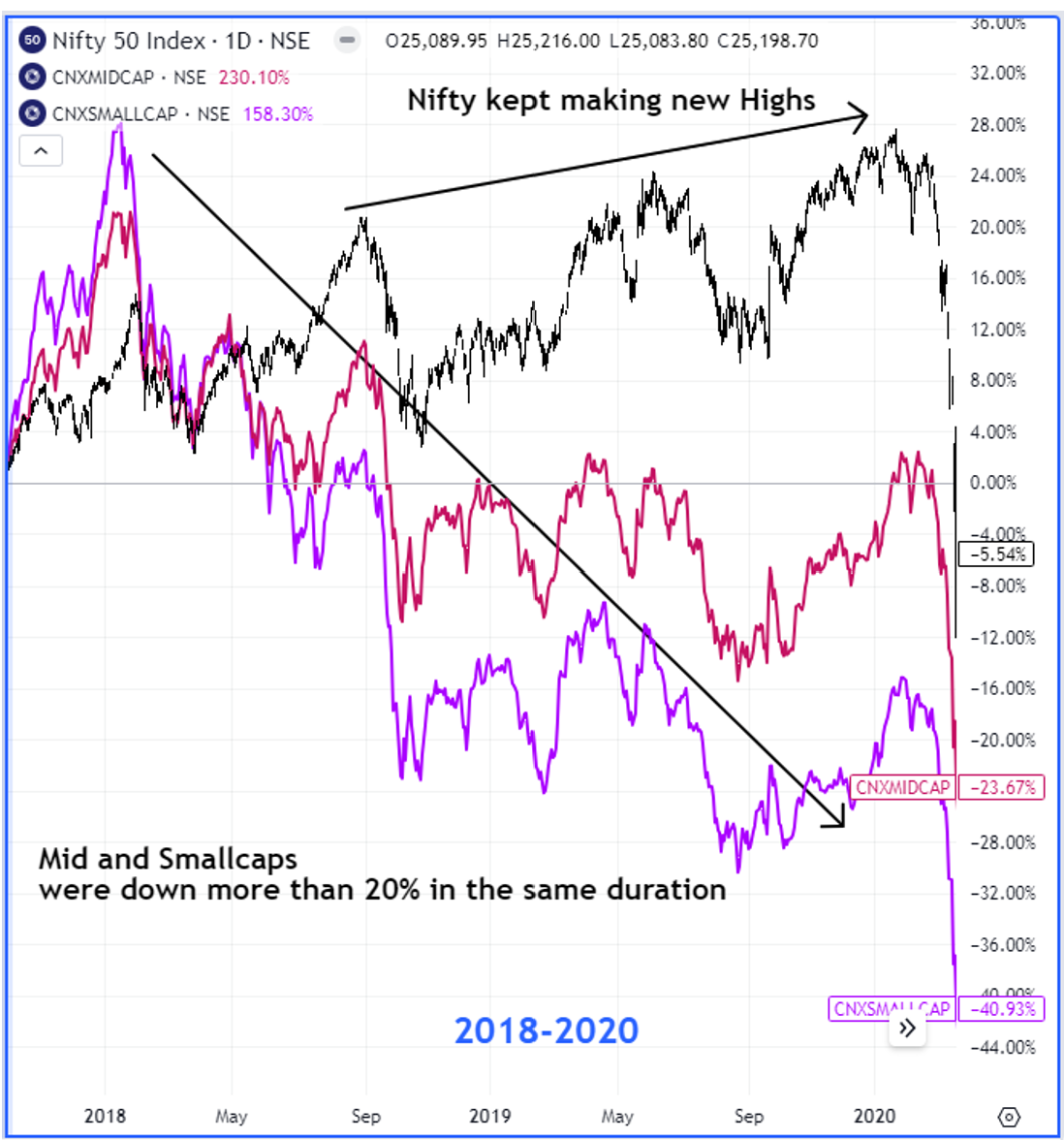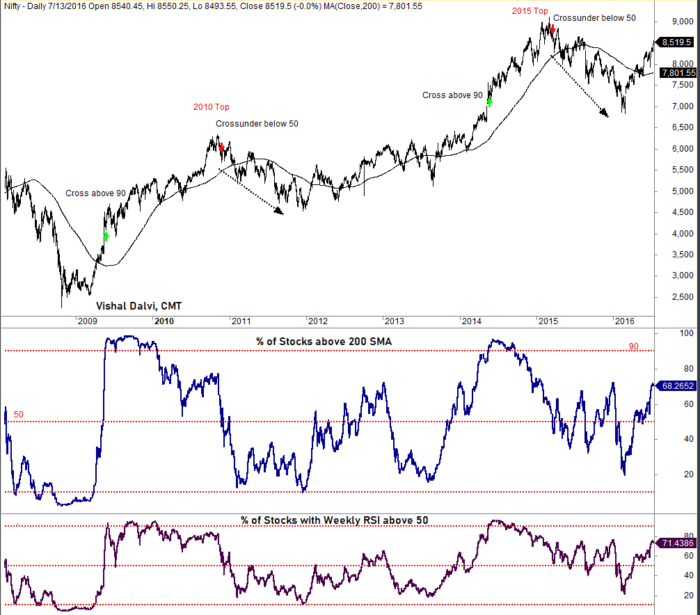By Vishal Dalvi, CMT
1/ Nifty 2010 & 2015 Top
2/ Nifty 2020 & 2022 Top
3/ Nifty v/s Midcap100/Small cap100 comparison – 2018-2020
4/ 2022 Top – Into the New Era
5/ 2024 The Current Rally
Investopedia is partnering with CMT Association on this newsletter. The contents of this newsletter are for informational and educational purposes only, however, and do not constitute investing advice. The guest authors, which may sell research to investors, and may trade or hold positions in securities mentioned herein do not represent the views of CMT Association or Investopedia. Please consult a financial advisor for investment recommendations and services.
1/
Nifty 2010 & 2015 Top
Finding an Index Top is one of the most challenging tasks as a trader/investor. One of the best methodologies to find a potential market top is to identify an extreme or weak breath as the Index price gets overbought.
2 indicators that can help spot a potential peak is
-% of stocks above 200 daily simple moving average (%SMA200)
– % of stocks with Weekly RSI above 50 (%WRSI50)
Let’s look at some historical tops made in the past for Nifty Index and how these indicators have helped to identify a Top.

Plotted above is a Log scale chart of Nifty Index along with the 2 indicators mentioned above.
2009-2010 Bull Market came after a strong bear market in 2008. Post the 2009 Election results, Market hit an upper circuit of 20% in a day and in few days more than 90% stocks in NSE were above their 200-day simple moving average. There are 2 implications of this data. Either Market is extremely overbought given that everything has moved up; or it signals a fresh Market breakout with huge participation. In 2009 this is a strong breakout signal; especially because it comes preceded by strong oversold bear market prices. The second indicator %WRSI50 also went above 90. What is important to note in the following rally is that prices continued to move higher but the %SMA200 continued to fall gradually.
Whenever %SMA200 breaks 50 on the downside (which usually occurs in the first leg of the start of bear market); it is a strong reversal signal and most likely a top is in place. Given that market is scaling new highs and even then, if only 50% of the stocks are above 200 SMA is a sign of weak breath in the Market which leads to a sell off. Markets crashed 24% post the Sell signal till Dec 2011.
Note, just a cross under of 50 level in itself has no importance, unless it is preceded with a crossover of 90 level, signaling a bull market and a full-scale participation.
2014 Bull Market was when BJP government had a clean sweep victory and Narendra Modi became the Prime Minister of India for the first time. Note this bull market is quite different structurally as it comes after 3 years of consolidation unlike 2009-2010 which was preceded by a Bear Market. The same pattern repeats. Market continues to scale higher and less and fewer stocks are able to stay above their 200 daily moving average. Finally, when the fall starts in March 2015 the %SMA200 fell below 50 and markets corrected 20 % post that.
2/
Nifty 2020 & 2022 Top

2020 Top in Indian Stock Market was a unique scenario. 2016-2018 Bull market saw a huge participation of Small and Midcap stocks and those actually topped out in 2018. Somehow the %SMA never crossed 90 in this bull market. While Small and Midcap stocks topped in 2018, the Nifty index kept on making new highs, but the overall breath of the market continued to worsen, which can be seen with the 2 indicators plotted. The %SMA200 crossed under 50 in 2018 itself, except that it wasn’t preceded by a crossover above 90. The Markets finally topped in Jan 2020 and then came the COVID crash and market crashed nearly 40%.
3/
Nifty v/s Midcap100/Small cap100 comparison – 2018-2020

4/
2022 Top – Into the New Era
Indian Markets can be easily divided into 2 regimes. Pre and Post COVID. A lockdown with everyone working from home and a sharp correction in Markets along with Low Interest rates on FDs offered Equity Investment as a good investment opportunity; saw a surge of new Retail investor participation in Indian stock markets that has structurally changed the way market behaves. The %SMA200 crossed above 90 around November 2020 signally a fresh new Bull Market. The %SMA200 cross under happened around Feb 2022. If you observe this correction is quite different than that of the 2010, 2015, or 2020. Reason was that we are in the new regime, where huge FII selling are absorbed by huge domestic flow by new retail investors. The market only corrected around 11% post this sell signal and largely consolidate in a range till June 2023
5/
2024 The Current Rally

The current Bull Run post June 2023 hasn’t seen the %SMA200 or the %WRSI50 cross above the 90 mark. Both the indicators have flittered around 85 levels and haven’t been able to cross under 50 which clearly shows there is no warning signs yet. There are some reasons for this
Regime Change: As explained before every dip so far has been bought given the huge flows and there is a structural change in Market behavior.
Sector Rotation: Anything and everything are not running up at the same time. This Bull Run started with PSE Index taking the lead and it has constantly changed hands with other sectors taking the lead while some sector went into consolidating. This rotation keeps the market healthy and doesn’t lead to excesses.
Also, we need to now check whether 2018-2020 is repeating where the Nifty index keeps increasing and the underlying Midcap, Small cap spaces start correcting. But the below chart shows that isn’t the case yet. There is no divergence, and all 3 indices are strong and moving together.

To summarize, there are no signs to call a Market top yet. A move of %SMA200 above 90 would flag us to look for a break below 50 for signs of a potential top.
Having said that I would still trade this market with a lot of caution and take a cross under of %SMA200 below 50 equally seriously (even though it may have not gone above 90); since we have flirted with 85 levels, and this is a New Regime Markets. A regime change can set new rules and not necessarily replicate the past as it is.
Stay invested with caution.
(PS: The methodology used to calculate these indicators only include valid stocks above a dynamically set Market cap threshold ensuring a certain % of stocks are above it in NSE exchange. Stocks universe is reset quarterly for the purpose of calculation.)
—
Originally posted 5th September 2024
Disclosure: Investopedia
Investopedia.com: The comments, opinions and analyses expressed herein are for informational purposes only and should not be considered individual investment advice or recommendations to invest in any security or to adopt any investment strategy. While we believe the information provided herein is reliable, we do not warrant its accuracy or completeness. The views and strategies described on our content may not be suitable for all investors. Because market and economic conditions are subject to rapid change, all comments, opinions and analyses contained within our content are rendered as of the date of the posting and may change without notice. The material is not intended as a complete analysis of every material fact regarding any country, region, market, industry, investment or strategy. This information is intended for US residents only.
Disclosure: Interactive Brokers Third Party
Information posted on IBKR Campus that is provided by third-parties does NOT constitute a recommendation that you should contract for the services of that third party. Third-party participants who contribute to IBKR Campus are independent of Interactive Brokers and Interactive Brokers does not make any representations or warranties concerning the services offered, their past or future performance, or the accuracy of the information provided by the third party. Past performance is no guarantee of future results.
This material is from Investopedia and is being posted with its permission. The views expressed in this material are solely those of the author and/or Investopedia and Interactive Brokers is not endorsing or recommending any investment or trading discussed in the material. This material is not and should not be construed as an offer to buy or sell any security. It should not be construed as research or investment advice or a recommendation to buy, sell or hold any security or commodity. This material does not and is not intended to take into account the particular financial conditions, investment objectives or requirements of individual customers. Before acting on this material, you should consider whether it is suitable for your particular circumstances and, as necessary, seek professional advice.





















Join The Conversation
For specific platform feedback and suggestions, please submit it directly to our team using these instructions.
If you have an account-specific question or concern, please reach out to Client Services.
We encourage you to look through our FAQs before posting. Your question may already be covered!